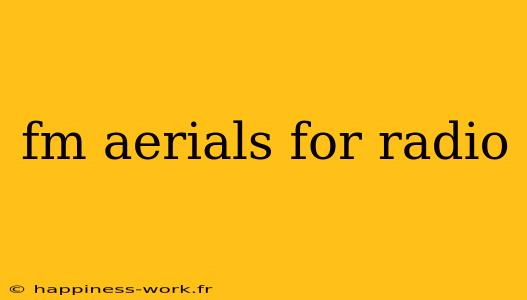FM aerials, or antennas, are critical components for receiving radio signals effectively. They come in various designs, suited for different requirements, and choosing the right one can significantly enhance your listening experience. In this article, we’ll explore common questions about FM aerials, provide insightful analysis, and share practical examples to help you optimize your radio experience.
What are FM Aerials?
FM aerials are designed to pick up Frequency Modulation (FM) radio signals. These antennas can be external or internal, with their effectiveness depending on various factors including location, signal strength, and interference. By understanding their construction and operational principles, you can make better choices regarding your radio setup.
Common Questions About FM Aerials
1. How do FM aerials work?
FM aerials operate by converting radio frequency signals into electrical currents. These antennas are designed to resonate at the frequency range of FM radio, typically between 88 to 108 MHz. When these signals come into contact with the aerial, they cause electrons to move, generating a current which is then transmitted to the receiver.
2. What types of FM aerials are available?
There are several types of FM aerials:
- Dipole Antennas: These are the simplest form of aerials, made of two conductive elements. They are often used for home radios and are effective for short-range signals.
- Yagi Antennas: More complex, with multiple elements, these antennas are directional and can receive signals from specific locations, making them ideal for long-distance listening.
- Vertical Aerials: Generally suited for urban areas, these are tall and can receive signals from all directions, which helps in overcoming obstacles like buildings.
3. How can I improve my FM radio reception?
To enhance your FM radio reception, consider the following tips:
- Positioning: Place your aerial as high as possible and away from electronic interference.
- Orientation: Experiment with the orientation of your antenna, especially if using a directional Yagi type, to find the best angle for reception.
- Upgrade Your Antenna: If you notice poor reception, upgrading to a higher quality aerial can make a substantial difference.
Analysis of FM Aerial Effectiveness
The effectiveness of FM aerials largely hinges on their design, location, and environmental factors. For instance, in rural areas, a Yagi antenna can provide a significant advantage over a simple dipole due to its ability to focus on distant stations. In contrast, urban environments often present a challenge due to obstructions, where vertical aerials might outperform others.
Practical Examples
-
Example 1: Rural Listening
A resident in a rural area may find that a Yagi antenna installed on the roof allows for clear reception of distant stations. In contrast, they might experience noise and distortion using a dipole antenna. -
Example 2: Urban Listening
An urban listener with a tall building blocking signals may opt for a vertical aerial placed on their balcony, allowing better signal capture from various directions.
Added Value for Readers
Tips for Selecting the Right FM Aerial
- Determine Your Location: Assess your proximity to FM transmitters. Tools like FM antenna mapping can help visualize signal strength in your area.
- Consider the Material: Antennas made from copper or aluminum are more effective than those made from plastic or coated materials.
- Analyze Your Needs: If you regularly listen to specific stations, choose a directional antenna to focus on those frequencies.
Maintenance Advice
To ensure optimal performance, clean your FM aerial periodically. Dust and debris can accumulate on the elements, diminishing signal quality. Additionally, check for corrosion, especially in outdoor installations, and replace any worn components as necessary.
Conclusion
FM aerials play a vital role in your radio listening experience. Understanding how they work, the types available, and how to enhance your reception can lead to significantly better audio quality. Remember that every listening environment is unique, so consider these factors carefully when choosing your FM aerial.
This article was informed by various sources, including insights from WikiHow’s articles on FM antennas. To learn more about how FM aerials work, visit WikiHow.
By optimizing your understanding of FM aerials, you can ensure that your listening experience is nothing short of exceptional. Whether you're enjoying music, news, or talk radio, the right FM aerial can make all the difference. Happy listening!
